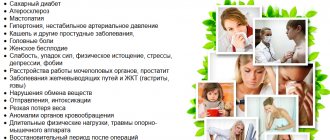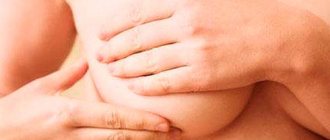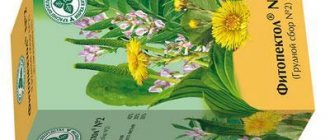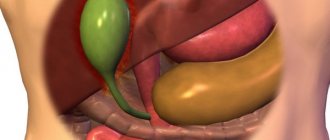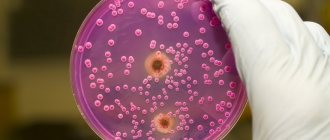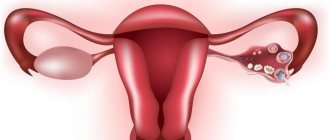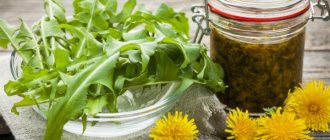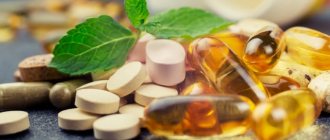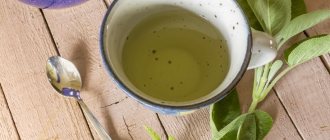Features of herbal medicine
Women's herbs should be used correctly, only then will it bring tangible benefits to the body. Before choosing it, you need to consult your doctor. Please note that treatment with herbal remedies is always long - from one month.
Familiarize yourself with all available indications and contraindications in advance. You should not practice herbal medicine on menstrual days; it is better to take a break during this period.
Plants with estrogenic effects must be taken from the fifth day of the menstrual cycle to the 15th. Herbs characterized by progestogenic activity are consumed from the 15th to the 25th day of the menstrual cycle.
Herbal therapy takes place in courses. There should be no more than three identical herbal courses per year. It is better to make alcoholic tinctures not with vodka, but with medical alcohol (40%). Plants should not be poured with boiling water; the water should cool to 70-80 °C. The decoctions are not boiled, but prepared in a water bath. If the herb contains phytohormones, then it cannot be combined with hormonal medications.
The use of herbs in gynecology
In the modern world, there are many reasons that contribute to the occurrence or exacerbation of gynecological diseases in women. Among them: adverse environmental influences, social stress factors, uncontrolled use of medications, including hormonal contraceptives.
Many herbs are used to treat various diseases. Most of them belong to the medicinal category, but among them there are also those that are commonly called weeds. Even ancient healers improved women's health with the help of medicinal herbs in gynecology. They were used by Avicenna and Hippocrates. In their medical treatises, they wrote about studies of plants rich in phytohormones. For a long time, doctors recommended that women use them as contraceptives, or, conversely, as means that stimulate female fertility, that is, the ability to conceive.
Herbal preparations have a complex effect on the entire body. However, before you begin a course of treatment with medicinal herbs, you should consider a few basic points.
- Get an accurate diagnosis from a medical specialist and consult with him about taking medicinal herbs.
- Do not expect immediate results as herbal treatments last for a longer period of time than medical treatments.
- Find out the indications and contraindications before starting to use medicinal herbs.
- Study the recommendations of experts on the proper preparation of decoctions and tinctures at home.
The most popular herbs for women's health
Any plant has many beneficial properties, and women’s grass especially. It can be consumed either independently or in collections, along with other plants. The latter option will expand the area of influence on the body and enhance the beneficial properties of the drug. Most often, the herbal preparation is consumed in the form of tea, infusion or decoction. Honey and lemon are added to them for taste and to enhance beneficial qualities.
The most beneficial herbs for women's health are as follows:
- red brush;
- hog uterus;
- Salvia officinalis;
- calendula;
- water pepper;
- stinging nettle;
- wormwood;
- shepherd's purse;
- pharmaceutical camomile;
- yarrow;
- St. John's wort;
- knotweed;
- Greek fenugreek;
- motherwort;
- raspberry leaves.
These and other plants will help not only maintain health, but also relieve many diseases. Sometimes they even solve problems that drugs cannot cope with.
Therapeutic effect of herbs
Herbs with an anti-inflammatory effect have the most valuable qualities, and first of all, they purposefully treat a specific ailment (both independently and in combination with other herbs). In addition, thanks to plants, the general condition of the body improves and the immune system is stabilized. Medicinal herbs have the following basic properties:
- antipyretic;
- pain reliever;
- anti-inflammatory.
Plants with anti-inflammatory effects have the following qualities:
- Protect the mucous membrane from mechanical and chemical damage.
- They have an antimicrobial effect.
- Activate mucosal renewal.
- Reduces the formation of hydrochloric acid.
The medicinal herbs used are different in each case, depending on the type of disease, as well as the goal pursued.
Salvia officinalis
Sage has a beneficial effect on the female hormonal system. The herb for women reduces pain during menstruation. Helps to conceive a child in case of infertility and stops lactation when necessary. The astringent properties of the plant help reduce the severity of bleeding. The estrogenic effect of the herb is indispensable during menopause. Sage is especially useful for hot flashes. This plant is a natural phytoestrogen. It is recommended for women with low levels of female hormones.
Women who want to get pregnant should drink the herb in the first half of the cycle, that is, after the end of menstruation, for 10-14 days, before ovulation begins. Take the decoction on an empty stomach, in the morning and before bed, but only by those people who have low estrogen levels. If everything is fine with the hormone level, then this herb should not be used, since excess estrogen leads to premature rupture of the follicle and the release of the egg.
It is recommended to drink sage in the form of decoctions and infusions, a glass a day. This amount is divided into 2-3 doses. The course of treatment is from 1 to 3 months. After a month it can be repeated.
For ladies over 35, sage will help rejuvenate the body. To do this, three times a year, for a month, you should drink a glass of herbal infusion with honey and lemon in the morning.
Sage has anti-inflammatory and disinfectant properties. It is considered an excellent antiseptic, so it is often used to gargle for colds. Has a slight androgynous effect. In high doses it can suppress gonadotropins and FSH.
Sage should not be taken during pregnancy and lactation. The herb is contraindicated for polycystic disease and hypothyroidism. The plant is prohibited for use in cases of endometriosis and fibroids, as well as in case of increased estrogen levels and progesterone deficiency.
Herbs in gynecology
Since the times of Hippocrates and Avicenna, it has been known about the use of a number of plants and vegetables rich in phytohormones as contraceptives or, conversely, fertility stimulants. Phytohormones can exhibit the properties of estrogens, androgens, corticosteroids or progesterone. The most numerous (several hundred) group of herbs contains phytoestrogens - substances similar in action to female sex hormones. Among the well-known medicinal plants, phytoestrogens contain hops, sage, sweet clover, clover, licorice, oregano, linden flowers, mistletoe and many others. Herbs with androgenic activity (stimulating the production of male sex hormones in the body): calamus, hogweed, lovage, celery, spring grass, rapeseed and others. Herbs with progestogenic activity (stimulate the production of progesterone in the body) are widely used. These include: sacred vitex, meadow lumbago, cinquefoil, mantle, raspberry and others. Of the plants of this group, I would especially like to note the sacred vitex (popular names - Abraham tree, twig, agnus kastus), which stimulates the pituitary gland to produce luteinizing hormone (LH), which in turn stimulates the production of progesterone. Less commonly used are herbs with antihormonal activity (suppress the synthesis of sex hormones in the body). These include: medicinal sparrow, common bruise, comfrey, blackroot and others. Even less commonly used are herbs with antiprogestogenic activity that block the production of progesterone (carrot seeds, especially wild carrots and others). Infertility due to high prolactin levels is becoming increasingly common. Prolactin is in an inverse relationship with progesterone, so herbs with a progestogenic effect are prescribed to slow down the production of prolactin by the pituitary gland. Considering that prolactin levels increase hypothyroidism, you need to add herbs to correct thyroid function. In case of immunological infertility (when a woman produces antibodies against her husband’s sperm), a good effect is observed when both spouses are treated with hemlock at the same time. Basic principles of herbal medicine: 1. Before you start drinking herbs, you need to find out your hormonal level. For the treatment of infertility, this is, first of all, estradiol in the first half of the cycle and progesterone in the second phase (6-7 DPO). But it’s better to take all the hormones 2. Decide exactly what needs to be treated, what needs to be corrected. 3. Know clearly the indications and contraindications for taking herbs. 4. Taking herbal phytohormones should not be combined with hormones. 5. Herbal treatment is long-term. There is no need to wait for a quick effect. The first successes should appear after 2-4 weeks of use. The duration of treatment is related to the duration of the disease. Usually the course is 1-3 months. 6. Monitoring hormone levels and periodic ultrasound of the pelvic organs when taking herbs is mandatory - after 1-3 months. reception (or after 1-3 cycles of reception). 7. During menstruation, taking herbs is not advisable. 8. Herbs with an estrogenic effect for the treatment of infertility are also prescribed in the first, follicular phase of the menstrual cycle, but they must be used from the 5th to the 15th day of the menstrual cycle (that is, from the 5th day from the beginning of menstruation). 9. Herbs with a progestogenic effect are prescribed in the second, luteal phase of the cycle, and they should be used from the 15th to the 25th day of the cycle. 10. All herbs are drunk in a course of no more than 3 cycles with a break of 1 cycle. 11. Alcohol tinctures should not be made with vodka, preferably with 40 percent medical alcohol (in the text there will be instructions to fill with vodka - left for shortening) 12. No herbs are brewed with boiling water, only with hot water 70-80 degrees. 13. When preparing decoctions, do not boil the infusion over an open fire, only in a water bath. Main abbreviations in the text: BM-hog uterus KSH-red brush M-menstruation DC-day of the cycle (days of the cycle) BT-basal temperature MC-menstrual cycle O-ovulation
Hog queen (Ortilia unilateral)
Since ancient times, this herb has been used to treat infertility. It may look unattractive, but it has enormous benefits! It has a diuretic, disinfectant, strong antitumor, absorbable and anti-inflammatory effect. BM treats gynecological inflammations, obstruction of the fallopian tubes, adhesions, fibroids and uterine cysts, ovarian cysts, endometriosis, uterine polyps, erosion, uterine bleeding, restores the menstrual cycle, and is used for severe menopause. BM also strengthens the fetus and is used to prevent miscarriage and helps with toxicosis of pregnancy. In addition, it perfectly treats diseases of the kidneys and bladder: pyelonephritis and cystitis, and is used for hemorrhoids. It should be remembered that in women, the breasts and uterus are closely interconnected, they even say “one organ,” so BM is also used for breast tumors: mastopathy, fibroadenoma, etc. BM is also used in the complex treatment of malignant tumors: breast cancer, uterine cancer . BM can also help men with inflammation of the prostate gland - prostatitis. So, she awarded not only women with her healing power! BM contains: arbutin, hydroquinone, coumarins, vitamin C, hydroquinone, resins, flavonoids, bitter substances, saponins, tartaric and citric acids, trace elements: titanium, copper, zinc, manganese. The duration of taking BM for various diseases depends on the degree of neglect of the disease. Herbalists believe that for each year of illness you need to take 200-250 ml of tincture. The most common methods of use: Decoction: 1 tablespoon of herb per glass of hot water (not boiling water), boil in a steam bath for 5-10 minutes, leave for 3-4 hours , strain. Take 1 tablespoon 4-5 times a day. Brew pharmaceutical herbs strictly as indicated on the pack. Packages from different manufacturers indicate different brewing methods, because... If you look closely, the grinding is different, hence the difference in dosage. Tincture: proportion 1:10 50 g of herb, pour 500 ml of diluted and 40 degrees alcohol (not vodka), leave for 3 weeks in a dark place, strain. Take 15-30 drops 3 times a day. This amount is designed for approximately 3 months of use. Or 1 tsp. dilute tinctures with 1 tsp. water and take 2 times a day. Drink for 3 months, gradually increasing the dose to 1 dessert spoon, then to a tablespoon. It is believed that the tincture (in drops, not cups) has a much stronger effect than a water solution. Douching: infuse two tablespoons of the herb into a glass of boiling water for two to three hours. At the very beginning of taking BM, BT may jump, since old diseases may remind themselves again - this is normal. After some time, usually after a month of use, BT returns to normal, unless, of course, there are any serious diseases. BM, like the Red Brush, tends to provoke stagnant diseases at the beginning of use. In no case does BM block ovulation; we must not forget that the presence of anovulatory cycles is the norm, not a pathology! When taking BM throughout the entire cycle, a shift in day O is possible. BM is suitable for those who have too large an endometrium, i.e. endometrial hyperplasia is present, and this is due to increased estrogens. BM helps to reduce or even disappear fibroids. And because Hyperestrogenism is considered one of the causes of fibroids, then we can certainly say that BM helps to lower estrogen, therefore, if estrogen levels are low, it is recommended to take BM only in the 2nd phase of MC and conduct control studies of the hormone level to determine the effect of the herb on your body. You can start drinking BM from any day of the cycle, without waiting for the start of a new cycle. They always drink BM until their period comes, without focusing on the schedule. The effect of BM on menstruation is different for everyone; it can become more abundant, or more painful (which is rare), or scanty. It all depends on the individual characteristics of the body. BM only strengthens the ongoing pregnancy, so it is not recommended to suddenly stop taking BM when pregnancy occurs, but by gradually reducing the dosage, reduce the intake to nothing. BM has a beneficial effect on ovarian cysts, resolving them; in this case, it is possible to take the herb throughout the entire MC, starting from the last day of discharge. BM can be taken with elevated androgens. By the way, elevated male hormones have a very bad effect on the fetus, especially if it is a boy, and there are often missed pregnancies and miscarriages due to this type of disorder. To maintain the 2nd phase, drink BM when progesterone is normal, and Utrozhestan (Duphaston) when progesterone is low. BM is recommended for balancing hormonal levels in case of minor disorders. Contraindications: It is not recommended to take BM if the diagnosis is tubal obstruction, since the development of an ectopic pregnancy is possible. BM is possible, but not recommended, to be taken together with OK if you need to get rid of inflammation, infections in the genitourinary system, but not if you are planning a pregnancy in this particular cycle. The simultaneous use of BM with sage is not recommended (although it is possible). If BM, when taken on an empty stomach, causes acute, unpleasant long-term sensations (for example, with gastritis), then it is recommended to take it after a meal 20-30 minutes later, the therapeutic effect weakens somewhat but is not lost, but it is not recommended to increase the dose. I rarely experience headaches or migraines. Also, BM in the first cycle can cause a delay in menstruation. BM is not taken together with the drug Estrogel, because it contains estrogen. I take the drug in the 1st phase, and BM in the 2nd. Drink BM only after finishing taking estrogel. Based on reviews from forum users, we can conclude that when using BM, the following changes can be observed: lengthening or shortening of cycles in different directions, exacerbation of chronic diseases at the beginning of use, increased menstrual flow, relief of PMS, improvement of the BT schedule, onset of ovulation, normalization of temperature differences and, finally , the onset of pregnancy!!!
Salvia officinalis
It has a particular effect on the hormonal function of women. It is known that sage reduces the pain of menstruation, promotes conception in case of infertility, and during breastfeeding it helps stop lactation. Sage is recommended for menstrual irregularities. The astringent properties of the plant help slow bleeding, and the estrogenic effect of sage makes it an excellent medicine for menopausal problems, especially hot flashes. Sage is a phytoestrogen, a substance of plant origin, similar in chemical structure to estrogen produced by the human body. Estrogen is a female hormone involved in follicle formation. Suitable for those who have low estrogen levels, a small endometrium and poorly growing follicles - but when you drink it, ovulation may be postponed for an unforeseen period and, accordingly, a deceptive delay in menstruation will occur. It is recommended to drink sage in the first half of the cycle (after the end of menstruation for 10-11 days, approximately before the start of ovulation) in the morning on an empty stomach and in the evening before bed, and only for those women who have low estrogen. An excess of this hormone causes the egg to burst prematurely. While taking sage, if there is a lack of progesterone in the 1st phase, you can take Duphaston or Utrozhestan. You should remember to use sage in moderation: allergies may occur, and large doses can lead to poisoning. When taking sage, the 1st phase can either increase or decrease, this depends on the level of your own estrogen in the blood. In order to drink sage you need to know your hormones in the first phase. And the most important thing: when engaging in such self-medication, you need to listen to your body, it itself will hint with some kind of cork that something is wrong. The most common methods of use: Sage can be sold both in loose leaves and in bags. Brew sage leaves as follows: 1 tsp. in a glass of hot water, leave for 15 minutes. Strain. Take 1/3-1/4 tbsp. 20 minutes before meals 3-4 times a day, but not at night. Brew a new portion every day. Brew 1p in tea bags. per glass of water, apply ½ 2 times a day or ⅓ for 3 doses. It is not recommended to prepare an alcohol tincture, although there are recipes: 50 grams per 0.5 liter of forty percent alcohol. Leave for 21 days or more, foam, green, then brown and thick like liqueur. Strain. Drink 1 hour at a time. l 2 times a day. There are recommendations for taking sage tincture with wine. Douching: brew 1 tablespoon per 1 glass of hot water. The course of treatment is 3 months and if pregnancy does not occur, then take a month break, and then you can repeat the course. For women over 35 years of age, it is useful to carry out a course of rejuvenation: three times a year for a month, regularly in the morning, drink a glass of infusion: 1 teaspoon of sage per glass of boiling water. Leave until cool. Drink slowly, 30-40 minutes before meals. You can add lemon or honey. For colds, sage-based tablets are often prescribed; they can be used in any phase of the cycle, since the amount of herbal extract in them cannot affect the condition of the fetus if pregnancy occurs. Sage can and should be taken if you have a cold, even during pregnancy, Thus, sage leaves have disinfectant, anti-inflammatory properties, are a good antiseptic and have a beneficial effect on colds, the only difference is that they are used as a rinse. Sage has a slight androgynous effect (stimulating the production of male sex hormones in the body), and in large doses, it suppresses FSH and gonadotropins. If you combine sage with linden, the results will be faster and more noticeable. Contraindications: During pregnancy, sage is strictly contraindicated, especially in the early stages - it increases estradiol and reduces progesterone, and this is VERY DANGEROUS. You should also not take sage while breastfeeding. Sage is strictly contraindicated in polycystic disease (the result of excess estrogen), you must first increase progesterone so that under its action, all the follicles that once did not ovulate from the cysts move into the corpus luteum and die, and then drink sage and grow new follicles. Excess estrogen only makes polycystic disease worse. Sage should not be taken for hypothyroidism (long-term, persistent lack of thyroid hormones); it is indicated for hyperthyroidism. Can be replaced with other phytoestrogens - for example, hops or linden or raspberry leaf. Sage, and any herbs, just like medications that have an estrogenic effect for fibroids and endometriosis - are strictly prohibited! It is strictly forbidden to drink sage if you have high estrogen. Since sage helps to grow follicles, if they are growing well without taking it, you should not drink sage, as there is a possibility that the follicles will overgrow, but will not burst and turn into cysts. Sage with progesterone deficiency can cause persistence (degeneration of follicles into cysts). If you experience discomfort while taking sage, it is better to stop taking it immediately. Based on reviews from forum members, we can conclude that taking sage helps increase the level of the hormone estrogen, thickens the endometrium, the ovaries begin to ovulate on their own and, as a result, pregnancy occurs.
Red Brush (Rhodiola tetrapartite, Rhodiola tetrapartite, Rhodiola tetrapartite).
KSh is used for oligospermia, weakened potency, infertility (male and female), sexual coldness, menstrual irregularities, adnexitis, menopause, mastopathy, polycystic and ovarian cysts, hypothyroidism, mastopathy and other hormonal disorders. Increases mental and physical performance. Recommended for cancer, improves blood composition. Increases resistance to infectious diseases. Of all the currently known plants and medicinal preparations, KSH has the highest immune and adaptogenic properties for restoring the body. It contains anthocyanins and betaines, which gives it its red appearance. In Altai folk medicine, KSH is used by women to treat mastopathy, uterine fibroids and fibroids, cervical erosion, uterine and ovarian cysts, endometriosis, painful and irregular menstrual cycles, and absence of menstruation associated with hormonal disorders, bleeding, tumors of various etiologies. KSH helps eliminate endocrine disorders: goiter, diseases of the adrenal glands, lymph nodes, kidneys, etc. KSH has a pronounced hemostatic and mild tonic effect. Relieves spasms of cerebral vessels (preferably than nootropin, which has a number of contraindications). The most common methods of use are: Tincture: 50 g of dry root is crushed, poured with high-quality vodka (500 ml), infused in a dark glass container for at least 30 days in a dark place, shaking occasionally. Strain. Take 30-40 drops (less than a teaspoon) 3 times a day 30-40 minutes before meals. The course of treatment is 30 days. Then after some time (10-15 days) the course is repeated. Decoction: 1 tablespoon of dry crushed root is poured into 300 ml of water and boiled for 5 minutes in a sealed container, then allowed to brew for at least an hour. Take 100 ml 3 times a day 30-40 minutes before meals with a teaspoon of natural honey. The course of treatment is 30-45 days. Douching: 1 tsp. tinctures per 0.5 liters of warm boiled water. Douche morning and evening for 10-15 minutes. The course of treatment is 7 days. Then a 7-day break, repeat 2-3 courses if necessary. KSH is a natural adaptogen (drugs of natural origin that can increase the body’s nonspecific resistance to stress). KSH is one of the best means for raising and protecting the immune system. Efficiency in the treatment of KSH is higher in cases where it is used with herbs such as boron uterus, wintergreen, wintergreen, red root, as well as hemlock, wolf's bast, Siberian princeling, horse chestnut, etc. KSH - has a beneficial effect on the second phase of the menstrual cycle (i.e., it should be taken after taking sage is completed), within 12 days after ovulation. Just like Borovaya uterus, it prevents inflammatory processes. It is better to take with a teaspoon of honey. It is possible to take it together with sage in the first phase, if it is necessary to treat any other disease (for example, fibroids). The effect of KSH can be enhanced by making a collection with other adaptogens: Eleutherococcus, Leuzea, Rhodiola rosea, Aralia, Zamanika, Schisandra. A collection is prepared from pre-crushed plants in a 1:1 ratio. Two tablespoons (with top) are poured into 1 liter of boiling water, left overnight in a thermos, taken during the day. The course of treatment is 2 months. Contraindications for use are the same as for KSH. Borovaya uterus and KShch complement and enhance each other’s properties. They can be infused and taken together: 25 g of boron uterus and KShch per 0.5 liter of vodka. Leave for 2 weeks. Take 1 teaspoon with water 3 times a day before meals. Other ways to take Borovaya uterus and KSH together: it is very important to follow the dosage regimen and avoid overdose. Taking these two herbs is always done in four stages. Each stage lasts 2 weeks. The mandatory break between doses lasts from one to two weeks, depending on how you feel. During the treatment process, water infusions should be used. Take on an empty stomach 3 times a day: in the morning - before 9:00, at lunch 1 hour before meals, in the evening - at 19:00. The infusion is taken 1 tbsp. spoon with a small amount of natural honey. If after the treatment course symptoms of the disease remain, then before the second course you should take a month's break, during which you can drink wintergreen infusions brewed and taken according to the same regimen. The course of treatment is designed for 70-100g. Borovaya uterus and 70-100 g of KSH Contraindications: Taking KSH is incompatible with hormones (synthetic and natural origin). Herbs include: hops, clover, licorice, cocklebur and other hormone-containing herbs. It is not advisable to use a brush if your blood pressure is above 180/100, because Taking KSH during pregnancy is strictly contraindicated, as it has an abortifacient effect. An overdose may cause drowsiness and lethargy.
Standard dosage regimens: With low estrogen levels, poor maturation of follicles: 1st phase - sage 2nd phase (or the entire cycle) - hog uterus For early menopause: hog uterus, red brush the entire cycle. First, in small doses, gradually increasing to normal ones, you can add a little burdock root to the herbs (a very good stimulant). After leveling the cycle, if necessary, sage is introduced into the 1st phase. For elevated prolactin: Prolactin is in inverse relationship with progesterone, so herbs with a progestogenic effect are prescribed. These include: sacred vitex, meadow lumbago, cinquefoil, mantle, raspberry and others. Vitex sacred or prutnyak in the form of tincture is sold by the drug "Cyclodinone". The components of the drug have a normalizing effect on the level of sex hormones. The action of the drug leads to a decrease in prolactin production and the elimination of hyperprolactinemia. Normalization of the synthesis and ratio of gonadotropic hormones leads to normalization of the second phase of the menstrual cycle. Cyclodinone can be combined with sage and Borovaya uterus.
For adhesions: You can drink Sporysh, but only before ovulation and under the control of testosterone and DHEA-S. You can use it together with sage (2 tablespoons of knotweed + 2 tablespoons of sage in 2 glasses of water, boil in a water bath for 15 minutes and take half a glass 30 minutes before meals) Improves flora, helps against erosion. In the second phase, it is not advisable to drink, as it increases uterine contractions. Particularly effective in combination with boron uterus. Infusion: 3 teaspoons of knotweed herb per 2 tbsp. boiling water, leave for 4 hours, drink half a glass before meals 3-4 times a day. For inflammation of the ovaries and infertility: you can use coltsfoot infusion with other herbs. To do this, mix 50 g of coltsfoot leaves, calendula flowers, centaury herb, chamomile flowers, and sweet clover herb. Pour 2 tbsp. spoons of the mixture 0.5 liters of boiling water, then leave for 2 hours. Strain and take 1/3 cup 6 times a day. The course of treatment is 1-2 months. To stimulate and heal the ovaries:
Herbal collection No. 1: sweet clover (herb) 1 part, common mantle (herb) 2 parts, sage (herb) 1 part, meadowsweet (flowers) 2 parts, knotweed (herb) 1 part. Prepare a decoction at the rate of 1 tbsp. spoon in a glass of water, keeping in a water bath for 15 minutes. Strain. Add water to the original volume. While the decoction is still hot, add 1.5 ml of 10% tincture of Rhodiola rosea (golden root) to it. Take 1/3 cup 3 times a day before meals.
Herbal collection No. 2: 2 tbsp. l. strings, 1 tbsp. l. yarrow, 1 tbsp. l. motherwort, pour all this into 0.5 liters of boiling water for 1 hour, then strain, drink the infusion in the morning, immediately after waking up and in the evening before bed, half a glass. You need to drink this tincture every day, in no case skip days, to regulate hormonal levels. Drink the entire cycle after the end of menstruation and before the start of the next one. You should not drink during pregnancy.
For polycystic disease, for infertility, for anovulation: The use of sage is not recommended, or in minimal doses and under ultrasound control. for the 1st phase of the cycle, i.e. before ovulation: rosemary (promotes ovulation, affects the sex gland), wormwood (promotes ovulation, removes toxins), elderberry blossom (supports the follicle-stimulating process), raspberry leaves (estrogenic). For the 2nd phase of the cycle: cuff (regulates the corpus luteum), yarrow (progestational), nettle (removes toxins). A scheme is also possible: drink boron uterus for 2-3 cycles, do an ultrasound check to make sure there is a result (reduction in the number of cysts), and drink BM (and maybe even Duphaston) until the cysts completely disappear, and then in the first phase introduce sage. For hypothyroidism (long-term, persistent lack of thyroid hormones): St. John's wort, celandine herb, rose hips, licorice root, angelica root, Rhodiola rosea root, cocklebur fruits - equally. Leuzea root, celandine grass, flax seeds, coltsfoot leaf, horsetail grass, cocklebur fruits - equally.
For PCOS: it is possible to use both the hog uterus and the red brush. It is recommended to alternate phases for 3 cycles. KShch is the first, BM is the second. Herbal medicine for acute and chronic adnexitis, to restore the patency of the fallopian tubes: Wintergreen roundifolia. 1-2 teaspoons of dry wintergreen leaves per 1 cup of boiling water. Infuse, wrapped for 2 hours, strain, squeeze. Take ½ glass 3 times a day. Tincture: 50 gr. leaves and stems of wintergreen per 0.5 liters of 40% alcohol. Leave for 2 weeks in a dark place. Take 30-40 drops 3 times a day. For anovulatory cycles: pour 1 tablespoon of dry plantain leaves (sold in pharmacies) with a glass of boiling water, leave it wrapped for 2 hours, strain. Take 1 tablespoon 4 times a day in the first phase. It is important to eat as many legumes as possible. For example, a glass of soybean grains (about 200 g) provides approximately 300 mg of the most important class of phytoestrogens - isoflavones. Research shows that regular consumption of soy reduces the frequency of hot flashes and also stimulates the proliferation of cells in the vaginal mucosa, relieving women of its dryness and irritation - common age-related changes that complicate sexual life.
Red brush, or Rhodiola quadrupartite
What herbs should be consumed for women's health? The red brush is one of those plants that women simply need.
The red brush has a wide range of uses. These are infertility, menstrual irregularities, lack of sexual desire, adnexitis, polycystic disease, menopause, ovarian cyst, mastopathy and other pathologies. The herb improves both physical and mental performance. Recommended for oncology. Positively affects blood composition. Helps fight infectious diseases. Removes spasm of cerebral vessels. It is characterized by adaptogenic, hemostatic, immune and tonic effects. Contains anthocyanins and betaines. Is a natural adaptogen.
Red brush is consumed in the form of tincture, decoction and used for douching. Its effectiveness increases in combination with the following plants:
- hog uterus;
- red root;
- wintergreen;
- horse chestnut;
- winterweed;
- prince of Siberia.
The plant is taken for two weeks after ovulation. It is possible to use a red brush with sage in the first phase of the menstrual cycle.
The herb in the form of an infusion is drunk on an empty stomach, three times a day, an hour before meals. Treatment is divided into four stages, each of which lasts 14 days with a break of two weeks.
Red brush should not be taken in combination with hormones, including those of natural origin. It is not recommended to use the plant for high blood pressure and pregnancy. In overdose, the herb causes drowsiness.
TOP 7 anti-inflammatory herbs
To obtain the most effective tinctures, the following types of herbs with powerful anti-inflammatory effects are most often used:
- Yarrow – has a bactericidal, anti-inflammatory effect. This herb is a powerful antiseptic and can be used as a hemostatic agent.
- Rosemary - a shrub with this name can be found in many regions. The plant is credited with not only anti-inflammatory properties, but also analgesic, tonic, and stimulating properties.
- Ginger is a natural anti-inflammatory agent actively used in Asian countries. Helps improve cerebral circulation, helps lose weight.
- Turmeric is not only an excellent anti-inflammatory agent, but is also used in the treatment of autoimmune diseases.
- Garlic is a natural antibiotic known all over the world. A tincture made from it perfectly cleanses the blood.
- Parsley - a tincture from the plant is used in the treatment of diseases of the stomach, kidneys, to strengthen the immune system, and in the fight against cancer.
- Licorice is an anti-inflammatory plant with a wide spectrum of action. Used in the treatment of fungal and viral infections, gynecological diseases, ulcers, etc.
Hog uterus (orthilia unilateral)
Another useful herb for the female body is boron uterus. It has long been used in the treatment of infertility. It is characterized by disinfectant, antitumor, anti-inflammatory, diuretic and absorbable properties.
Used in the treatment of inflammatory processes in gynecology. It treats obstruction of the fallopian tubes, adhesions, cysts, fibroids and ovarian cysts. It is also recommended to drink the herb for uterine polyps, bleeding, erosion and menstrual irregularities. A decoction of boron uterus is effective for endometriosis and severe menopause.
Oregano
The next flower that is included in the gynecological herbal collection is oregano. This plant has analgesic, antimicrobial and anti-inflammatory effects. Oregano can regulate the menstrual cycle and relieve pain during these days. This plant is also prescribed if it is necessary to improve or alleviate the condition of menopause. It is so often used in gynecology that it was given a different name - But it is worth remembering that oregano has many contraindications. It is especially harmful during pregnancy, as it can cause miscarriage.
Stinging nettle
Another indispensable female herb for the treatment of gynecological diseases is stinging nettle. It has a restorative, sedative, diuretic, antirheumatic effect. Causes appetite. Has a beneficial effect on the condition of hair. Helps remove dandruff. Improves cerebral circulation. Restores immunity, reduces pain and stimulates lactation.
In gynecology, the plant is used for bleeding, fibroids, inflammation, mastopathy, infertility and cervical erosion. The herb normalizes the menstrual cycle. Used for heavy and prolonged periods. Contains a lot of vitamin B and other substances essential for the human body.
When treating with nettle, any part of the plant is used: root, leaves, flowers and seeds. The herb is used in the form of infusion, decoction, juice and powder. Contraindications for use include pregnancy and an allergic reaction to the herb.
Types of Anti-Inflammatory Herbs
The following types of medicinal herbs are used to prepare tinctures and liqueurs:
- tannins,
- salicylates,
- gallic acid,
- phytosterols.
Salicylates are aimed at treating joint diseases (raspberry, meadowsweet, peony). Treatment of open wounds is carried out with the help of tannins (bergenia, alder). Phytosterols are powerful antioxidants that help lower cholesterol levels and improve immunity. Gallic acid has a powerful antiviral effect and is found in tea leaves and ink nuts.
Herbal teas for women's health
Women's herbs are, of course, useful, but when collected they are much more effective. Below are several medicinal preparations that will be useful for women.
Collection for candidiasis. Taken orally. It consists of sage, sweet clover, calendula, nettle, common mantle, as well as the fruits of gray alder, bergenia, yarrow and St. John's wort, taken in equal parts. One dessert spoon of this mixture is poured with boiling water in an amount of 500 ml. Infuse for four hours in a thermos. Strain. Consume three times a day, half an hour before meals. The infusion is drunk warm.
During menopause. During this difficult period for a woman, you can relieve the symptoms of illness as much as possible with this collection. To prepare it, you need to take clover inflorescences, anise seeds, heather, eryngium and mint herbs, as well as sweet clover. Yarrow and licorice rhizome are added to the collection. All components are taken in equal shares. For one dessert spoon of herbal mixture, take 0.5 liters of boiling water. Take 150 ml infusion three times a day. They drink for ten days, take a break for two days. Therapeutic course - from one month to three.
Feminine collection to stabilize hormonal balance. To prepare it, mix motherwort, lemon balm, alfalfa, mint, meadow clover, St. John's wort and oregano in equal quantities. A tablespoon is poured into a glass of boiling water. Leave for 20 minutes, strain and take half a glass twice a day.
Women's medicinal herbs are taken in a course that is determined individually for each woman.
Treating inflammation with herbs
Treatment of inflammation will be much more effective if you follow two simple requirements:
Daily routine – during the inflammatory process, sleep helps speed up recovery. And in turn, a sleepless night can aggravate the painful condition and negate the entire healing process.
Diet – if you have inflammation, you should not eat the following foods: eggs, milk, yeast, wheat, legumes and meat, especially pork and lamb, because they tend to increase inflammation. Vitamin C is a wonderful assistant in the fight against inflammation, so it is recommended to drink rosehip tinctures and tea with lemon.
When treating inflammation, do not forget about the characteristics of the body and possible allergic reactions. Therefore, you need to be careful when choosing herbal remedies and treatment methods.
Douching in the treatment of inflammatory diseases with herbs
Treatment of inflammation depends on the nature of the disease. And yet, herbs often become a panacea. We present to your attention recipes for douching preparations. It is best made from natural, medicinal herbs, the collections of which are presented below.
For douching against inflammation, take in the proportion of two parts linden color and three parts chamomile flowers, mix thoroughly, then four tablespoons tbsp. Pour boiling water (200 ml) over the resulting mixture and leave for 15-20 minutes.
Another popular recipe for treating inflammation with herbs. Willow bark, three parts, mixed with two parts linden color. Pour four tablespoons of tbsp into a container. collection and pour a liter of boiling water, after which it should be left for 2-3 minutes.
We take everything in equal proportions: sage leaves, black elderberry flowers, forest mallow flowers and oak bark. You will need five spoons of the resulting mixture per liter of boiling water. After it has infused for 20 minutes, you can treat inflammation with douching;
Douching in the treatment of inflammation with herbs (trichomoniasis colpitis). We take lavender (herb), bird cherry (flowers), and wormwood one part at a time; two parts each of marigold and sage flowers; and three parts chamomile. One spoon tbsp. Brew the impurities with a liter of boiling water and leave for two hours. Use for two weeks, each before bedtime.
Mix six parts of oak bark with four parts of oregano (flowers) and two parts of marshmallow (leaves). Treat inflammation with douching;
Perhaps the simplest folk recipe for the diagnosis of inflammation is to take chamomile and cinquefoil in equal parts and brew it.
Three parts of stinging nettle (leaves), mixed with one and five parts, respectively, of oak bark and knotweed. From the resulting collection, pour boiling water (1 liter) into two tablespoons of tbsp. The folk recipe is suitable not only for douching with herbs for inflammation, but also for baths and tampons.
Mix one part of oak bark, another part of mallow color with 1.5 parts of chamomile flowers and 2.5 parts of walnut leaves. Two spoons tbsp. you need to pour a liter of boiling water and use it for douching if inflammation is diagnosed. Can also be used for baths and tampons.
We take one part each of rosemary leaves, yarrow herb, rosemary casting and two parts of oak bark. Two spoons tbsp. per liter of boiling water.
In case of acute inflammation, douching is contraindicated. During the douching process, you need to sit in the bathtub in a supine position, with your legs thrown over the sides of the bathtub, then insert the tip of the douching vessel.
The procedure for douching with herbs for inflammation lasts 10-15 minutes, twice a day (for medicinal purposes), gradually reducing the number of visits.
Douching is intended for health purposes, since in a healthy state the body itself copes well with cleaning the genitals, with the help of a special viscous substance.
Herbs that help with menopause
Women's herbs during menopause give good results. During the period when reproductive and menstrual function fades, it is recommended to use plants with phytohormones.
Which herb contains female hormones? There are a lot of such plants. The most famous include: hogweed, sage, horsetail, licorice rhizome, black cohosh, dioscorea hairy, hop cones, raspberry leaves, mantle, red clover and angelica chinensis. Infusions and decoctions of these plants help normalize hormonal levels.
A collection of birch buds, yarrow, nasturtium and sage, taken in equal quantities, will help reduce the frequency and intensity of hot flashes.
A herbal mixture of lemon balm, valerian, blackberry (berries), mint, hop cones, motherwort, oregano, marsh cudweed, and evasive peony will soothe during menopause and normalize sleep.
For insomnia, you can use a mixture of tinctures of hawthorn, motherwort and valerian. Infusions in equal proportions are poured into one container and consumed before bed, 20-25 drops.
Oregano in combination with chokeberry will help stabilize blood pressure and heart rate.
A mixture of boron uterus, licorice root and oats eliminates urinary incontinence and discomfort in the vagina.
A decoction of dill also helps with menopause. To prepare it, pour a teaspoon of dill into a liter of boiling water. Drink 100 ml up to four times a day.
If you don’t want to bother with herbs, you can buy drugs at the pharmacy that contain phytoestrogens, which act in the same way as hormonal drugs. Among the most famous:
- "Inoclim" (soy-based).
- "Feminalgin" (consists of meadow lumbago, magnesium phosphate and black cohosh).
- "Estrovel" (contains nettle and a number of essential vitamins).
- "Feminal" (based on red clover).
- "Femicaps" (contains primrose oil, passionflower, soy lecithin, vitex fruit, vitamins E and B).
Any of the above drugs can alleviate a woman’s condition during menopause. You just need to choose the most suitable one for yourself and consult your doctor before using it.
Anti-inflammatory herbs
1. Yarrow.
It contains tannins, which have astringent, bactericidal and anti-inflammatory properties. This herb also has universal antiseptic properties. Plus, yarrow is also used as a hemostatic agent.
2. Rosemary.
It is an evergreen shrub that grows in many parts of the world. In addition to anti-inflammatory properties, rosemary has a tonic, stimulating, analgesic and diaphoretic effect.
3. Ginger.
In Asian countries, this miracle root is almost a panacea for all diseases and is used as a natural anti-inflammatory agent. It is simply a storehouse of vitamins, microelements and other useful substances. With its help, you can increase cerebral blood circulation, which has a positive effect on brain function, memory improves, and a person begins to think more clearly and clearly. Ginger also helps those who want to lose weight. For those who want to lose weight, I advise you to read the articles in the section
4. Turmeric.
This spice is used very widely in Mexican, Indian and Asian cuisines. Turmeric is recommended not only as an anti-inflammatory agent, it has also proven itself in the treatment of autoimmune diseases.
5. Garlic.
This natural antibiotic is widely used in almost all countries of the world. It is also used in the treatment of hypertension and diabetes. By making a tincture of garlic, you can cleanse your blood and become much healthier. How to properly prepare and take a medicinal tincture, read the article “
6. Parsley.
It is an anti-inflammatory herb that is very rich in vitamins and minerals, especially vitamins A, B, C and K. It is good for kidney and stomach diseases. This herb is very useful for strengthening the body's immune system. It is known that parsley can help prevent serious diseases such as rheumatoid arthritis and cancer.
7. Licorice (licorice).
This anti-inflammatory herb is used in the treatment of many diseases (viral and fungal infections, ulcers, liver and stomach diseases, women's diseases, inflammatory processes in the oral cavity, and so on). Due to the high content of flavonoids, licorice has strong anti-inflammatory properties. Licorice is also used as an antidepressant. But, it is important to know that excessive consumption of this herb can lead to heart problems (rapid heartbeat, difficulty breathing), so it is important to follow the dosage.
8. Boswellia.
These low shrubs are native to India and produce aromatic resins, such as incense. Indians call this herb an “inflammation fighter.” It is used in the treatment of gastrointestinal disorders, fever, rheumatoid arthritis and joint pain (in addition to relieving inflammation, this herb has a strong analgesic effect).
9. Cinnamon.
Many people like to add this spice to various baked goods, as it gives it a special taste and aroma. But, in addition to its culinary and taste benefits, cinnamon is good for inflammatory diseases.
These are not all medicinal herbs
, I in no way belittle the properties of chamomile, mint or St. John's wort. It’s just that the above herbs have proven themselves to be anti-inflammatory.
Of course, in case of serious illnesses, medications cannot be neglected. But in most cases, I prefer medicinal herbs and tablets
Be healthy and full of strength!
Plants for female potency (libido)
Herbs that increase female potency can be used in the form of infusions and decoctions. They can increase sexual desire. The most popular are:
- Tribulus creeping. Stabilizes or increases the production of estrogen and testosterone, increases libido.
- Damiana leaves. This herb can not only increase libido, but also has a positive effect on mood. Increases a woman's physical activity. A tincture or decoction is prepared from damiana.
- Shatavari. The plant rejuvenates both the female and male reproductive system. Increases the ability of eggs to fertilize. Increases libido even in women after fifty years of age.
- Wild yam. It is a direct source of progesterone and estrogen. Increases sexual desire.
- Rhodiola rosea. It has a beneficial effect on the entire female body. Increases sensitivity during sexual intercourse. Makes a woman more liberated and active in sex. The herb should not be taken by hypertensive patients.
All of the above herbs will help improve the quality of sexual life and make a woman more sexy.
Ready-made herbal teas for women
Gynecological collection usually consists of herbs that have a positive effect on the female body. The functioning of the genitourinary system is normalized, hormonal levels are restored. The fees will be effective even in case of minor reproductive failures and during planned prevention. But it is better to start treatment after agreement with the gynecologist. The following is an overview of popular herbal complexes for women.
Anastasia
This is a healthy herbal tea. It contains:
- hog uterus;
- Kuril tea (a plant in the form of a strongly branched shrub);
- wintergreen round-leaved.
There are several indications for starting use: eliminating unpleasant signs of toxicosis, fighting inflammation and uterine bleeding. Tea has a beneficial effect on the entire female body (elimination of migraines and high blood pressure).
The tea is packaged in convenient filter bags. 1 sachet needs to be filled with 100 ml of boiling water and left for 10 minutes. Drink a glass throughout the day (half a glass in the morning and evening). Drink for 28 days. Then take a break for 7-8 days and resume taking it.
Medicinal tea Evalar
Components:
| Action:
| Drink 2 glasses of Evalar tea a day. |
With a hog queen
This is a real “female” herb. It fights inflammation and has a resolving effect. Borovaya uterus is used to treat a number of severe pathologies without surgery:
- mastopathy;
- fibroadenoma;
- female infertility;
- polycystic ovary syndrome;
- adnexitis - inflammation of the appendages.
The herb also normalizes the menstrual cycle; with regular use, adhesions in the pelvic area are reduced.
Borovaya uterus can be drunk in its pure form: 1 tbsp. pour boiling water over the raw material and leave for 30 minutes. Strain the resulting infusion, drink a third of a glass 3 times a day. It is also permissible to drink the herb as part of tea or infusions (Altai herbal tea and others).
With a red brush
The official name of the plant is Rhodiola quadrupartite. Herbalists assure that this herb helps if a woman’s reproductive system is affected by the following pathologies:
It is effective to mix red brush with boron matka, fermented fireweed (Ivan tea). Ready-made mixtures can be taken orally, and liquids can also be prepared from them for lotions, baths and douches.
Using red brush in its pure form: 1 tbsp. herbs are poured with 100 ml of water, boiled over low heat for 5-7 minutes. The broth is cooled, filtered and used for treatment.
Anti-inflammatory
Inflammation of the female genital organs is a common problem with which people go to see a gynecologist. It is caused by various microorganisms (viruses, bacteria, fungi). To eliminate inflammation, pharmaceutical drugs and folk remedies are prescribed. Anti-inflammatory herbs in gynecology:
- chamomile flowers;
- knotweed;
- nettle;
- plantain;
- oak bark
Take the ingredients in equal proportions, brew with boiling water, cool to 37-38 degrees and use for douching. The anti-inflammatory collection has a beneficial effect on the vaginal microflora, kills and removes pathogens.
For fibroids
This is a benign tumor in the uterus. For treatment, a collection is used based on:
- common agrimony;
- wormwood;
- herbs celandine and motherwort;
- St. John's wort extract;
- extracts from rose hips;
- mint or lemon balm;
- immortelle;
- chamomile;
- valerian root;
- licorice.
The herbs presented have an antitumor effect, they stop inflammatory processes in the uterus. The components also have a cleansing, absorbable, analgesic, and general stimulating effect. Brew the collection and drink 2 glasses a day. The course of admission is 3-5 months.
For endometritis
This is an inflammation of the uterine lining. To combat the disease, several combinations of gynecological preparations can be used.
| Treatment with medicinal herbs | ||
| Way | Ingredients | Application |
| Option 1 | marshmallow and leuzea root (deer grass); lavender; sweet clover; wormwood; blueberry leaves; nettle. | Take an equal volume and grind. Take 2 tbsp for 0.5 liters of water. ready collection. Keep the drink in a thermos for 10-12 hours. Drink a third of a glass 4 times a day. |
| Option 2 | dandelion greens; marigold; bergenia rhizome; bearberry; chicory; coltsfoot. | Mix herbs, take 4 tbsp. collect and pour into a thermos. Pour 1 liter of boiling water. Leave for 12 hours (it is better to leave overnight). Drink a third of a glass 4 times a day. |
Russian roots
This remedy is indicated for use by women who have hormonal imbalance. The collection acts gently, stabilizes the cycle, facilitates the occurrence of PMS or menopause.
What does it contain?
- St. John's wort and yarrow. Help with heavy menstrual and uterine bleeding.
- Bird's knotweed. Relieves inflammation, diuretic effect. The herb stimulates uterine contractions and normalizes the cycle.
- Horsetail Relieving menstrual and menopausal pain. Stabilization of the urinary system during menopause (diuretic effect, bile outflow).
- Also contains nettle, calendula, oregano and mint. Herbs have a complex effect: disinfection, disinfection, calming.
Herbal infusions in gynecology are an irreplaceable and effective aid. Herbs have a multidisciplinary effect on the body: from eliminating the symptoms of diseases to preventing severe pathologies. The preparations can be used for oral administration or for baths, douching and wetting tampons.
“Herbal treatment is long-lasting! No need to wait for an instant (one cycle) effect! It is necessary to comprehensively eliminate all violations and only then can we talk about pregnancy! Patience and faith in success are the key to victory over diseases in herbal medicine. But everything must be kept under control. Periodically - hormones and ultrasound (once every 2-3 months).
Reviews of gynecological collection
Many women have tried the gynecological preparation on themselves. Reviews prove that herbal treatment is truly effective and strengthening. Of course, some people find the brewing process inconvenient and the fact that it doesn’t begin to help as quickly as they would like. But the advantage of this treatment method is that it has no side effects (if all contraindications are taken into account), as well as the duration of its beneficial effects.
It is worth noting that some types of preparations can be purchased in sachets, which makes their preparation easier. In addition, some women claim that after taking a course of gynecological collection, their skin, hair and nails have improved. But before you start taking herbs, you should consult a specialist for advice, since some plants may have serious contraindications, which are important to take into account so as not to cause harm to health.
The gynecological collection was created specifically for the complex treatment of many diseases of the reproductive system in women. In addition to the medicinal properties, the components of the gynecological collection have the ability to prevent exacerbations of chronic inflammatory diseases.
Inflammation of the cervix and vagina. Inflammatory processes in the ovaries. Prolonged uterine bleeding. To regulate the menstrual cycle. To eliminate signs of premenstrual syndrome and unpleasant symptoms of menopause.
Chamomile – has an anti-inflammatory effect, is involved in the regulation of the menstrual cycle, and also has a detrimental effect on some pathogenic microorganisms. For inflammatory diseases of the vagina, accompanied by heavy discharge, chamomile extract effectively eliminates itching.
Gynecological collection with boron uterus (red brush) is used to treat mastopathy, myomatous lesions, erosions and cystic changes. It is also widely used to reduce pain during menstruation. The use of a gynecological collection with a red brush helps to normalize the menstrual cycle.
This plant prevents the spread of the inflammatory process to neighboring organs and has a tonic property. Calendula – helps accelerate the healing of minor injuries and wound surfaces, eliminates inflammation. Due to its properties, it is often included in women's anti-inflammatory gynecological herbal teas.
A gynecological mixture with wintergreen has a powerful anti-inflammatory and analgesic effect not only for pathologies of the genital organs, but also for diseases of the urinary system. Acacia flowers have anti-inflammatory and antispasmodic properties. The hemostatic effect of acacia is also known.
Yarrow, which has an analgesic effect, also has the ability to stop bleeding, normalize and increase blood clotting. The cuff - in addition to its anti-inflammatory effect, can regulate hormonal levels and correct hormone imbalances. Raspberry leaves have a hemostatic and anti-inflammatory effect.
Nettle effectively eliminates uterine bleeding. Therefore, it is often included in a hemostatic gynecological collection along with mantle, burnet root, yarrow and bergenia. The herbs listed will help not only cope with bleeding, but can also be used during heavy menstruation to prevent large blood losses.
Tea - a gynecological mixture is available packaged in portioned bags or simply in the form of a dry crushed mixture of herbs. To prepare the drink, you need to pour boiling water over one sachet or 2 spoons of the herbal mixture. Next, you need to leave the tea to steep for 20-30 minutes. It is recommended to take three times a day 15 minutes before meals.
http://fb. ru/article/213388/ginekologicheskiy-sbor-trav-protivovospalitelnyiy
http://womanadvice. ru/ginekologicheskiy-sbor
The use of knotweed (knotweed) for the treatment of gynecological diseases
Regarding knotweed they write:
Knotweed (bird knotweed)
Many women were cured of infertility in a simple and accessible way: they drank knotweed without measure, like tea. Infusion of knotweed herb: 1 cup of dry herb per liter of boiling water.
In my opinion, it's too much.
Better: 3 tsp. spoons of knotweed herb in 2 cups of boiling water, leave for 4 hours, drink half a cup before meals 3-4 times a day.
You can induce menstruation in one of the following ways: Mix 1 tbsp. l. crushed buckthorn bark, lemon balm leaves, valerian root and cinquefoil herb. Full table. Add a spoonful of this mixture to a glass of boiling water. After it cools down, strain. Take 1/2 cup 4 times a day.
Start 3-5 days before expected menstruation and finish taking the day after it starts.
Or: By tea. l. mix crushed buckthorn bark, rue herbs, 2.5 teaspoons. Spoons of rosemary leaves. Pour 1 tbsp boiling water 1 tbsp. l collection. Start taking it a week after the planned M and drink for 8 days. It would be better to wait until the endometrium grows to at least 5-8 mm.
What herbs should you not drink during pregnancy?
Under no circumstances should you use certain types of plant materials: herbs that stimulate the hormonal activity of the gonads are:
- field cress,
- sage,
- dandelion,
- sweet clover,
- Walnut,
- black cohosh,
- field grass.
Pregnant women are contraindicated in using infusions and decoctions of herbs such as:
- marsh calamus,
- scarlet tree,
- wild rosemary,
- blue cornflower,
- elecampane tall
- oregano,
- wild strawberries,
- medicinal hyssop,
- lemon-shaped Kirkazon,
- burnet,
- sugar kelp,
- Leuzea safflower,
- lovage,
- common mordovnik,
- male fern,
- common tansy,
- wormwood,
- Tangut rhubarb.
You should be careful with garlic, celery, seaweed, parsley, dill, and pickles.
